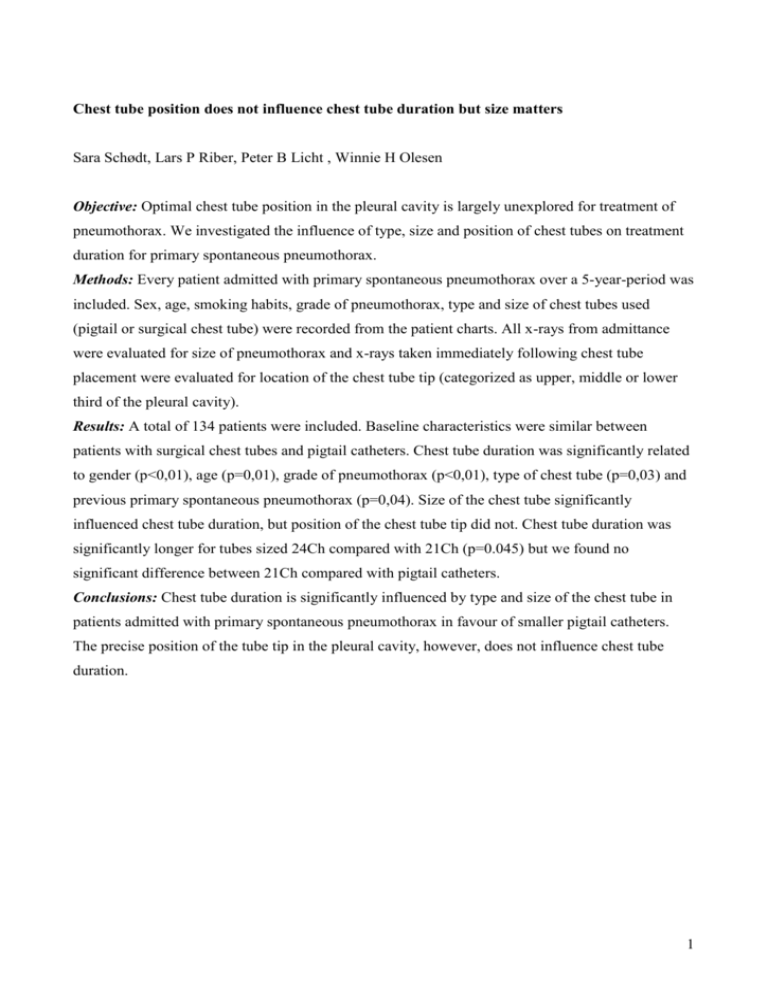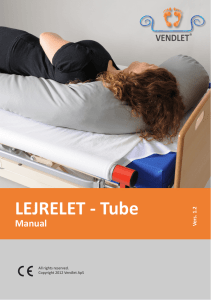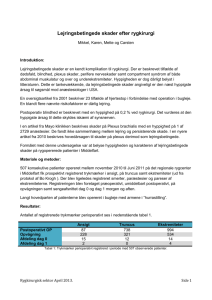Supplemental high thoracic epidural analgesia is associated with
advertisement

Chest tube position does not influence chest tube duration but size matters Sara Schødt, Lars P Riber, Peter B Licht , Winnie H Olesen Objective: Optimal chest tube position in the pleural cavity is largely unexplored for treatment of pneumothorax. We investigated the influence of type, size and position of chest tubes on treatment duration for primary spontaneous pneumothorax. Methods: Every patient admitted with primary spontaneous pneumothorax over a 5-year-period was included. Sex, age, smoking habits, grade of pneumothorax, type and size of chest tubes used (pigtail or surgical chest tube) were recorded from the patient charts. All x-rays from admittance were evaluated for size of pneumothorax and x-rays taken immediately following chest tube placement were evaluated for location of the chest tube tip (categorized as upper, middle or lower third of the pleural cavity). Results: A total of 134 patients were included. Baseline characteristics were similar between patients with surgical chest tubes and pigtail catheters. Chest tube duration was significantly related to gender (p<0,01), age (p=0,01), grade of pneumothorax (p<0,01), type of chest tube (p=0,03) and previous primary spontaneous pneumothorax (p=0,04). Size of the chest tube significantly influenced chest tube duration, but position of the chest tube tip did not. Chest tube duration was significantly longer for tubes sized 24Ch compared with 21Ch (p=0.045) but we found no significant difference between 21Ch compared with pigtail catheters. Conclusions: Chest tube duration is significantly influenced by type and size of the chest tube in patients admitted with primary spontaneous pneumothorax in favour of smaller pigtail catheters. The precise position of the tube tip in the pleural cavity, however, does not influence chest tube duration. 1 Mediastino-hepato-renal cystic lymphangiomas – diagnostic and surgical considerations Khalil Ahmad, Thomas D. Christensen, Henrik Vad, Kim Terp, Hans-Henrik Kimose, Vibeke Hjortdal Department of Cardiothoracic and Vascular Surgery Aarhus University Hospital, Aarhus, Denmark Abstract: Cystic lymphangiomas or hygromas are rare benign vascular tumours, caused by congenital malformation of the lymphatic vessels.(5,8) It appears as a progressive swelling in the head or neck of children during 2-5 years of age, yet rarely seen in the mediastinom or abdomen. Symptomatic mediastinal cystic lymphangiomas provides symptoms in terms of e.g. chest pain, breathlessness, cough, dysphagia, superior vena cava syndrome, making it difficult to differentiate from other mediastinal tumours. The tumour can become larger due to infections, inflammations, obstructions and bleedings. Chest X-ray, Ultrasonography, Computed tomography (CT), and Magnetic Resonance Imaging (MRI) provide helpful information but the correct diagnose appears after surgical resection and histomorphoimmunological tests. Only a few cases have been reported (4, 10). We report the first case of mediastinal and bilateral asymptomatic renal and multiple hepatic cystic lymphangiomas in a 71-year-old male with respiratory symptoms and sever reduction in lung capacity. The symptoms regressed fully after surgical excision. Lung diffusions capacity increased significantly. Keywords: Mediastinal lymphangioma, rare congenital malformation, Lymphoangiogenesis Introduction: Lymphagnioma is a rare benign tumour due to congenital lymphatic vessels abnormalities. Almost 90% of cases are diagnosed at birth or within the first 2 years of age (5), appearing often as fluctuant, freely mobile, compressible, and painless slow growing asymptomatic mass mostly in the head and neck, occasionally in axilla, or groin. The cysts can occur any where in the lymphatic channels of the body. The patients are seldomly symptomatic. Case report: A 71-year-old man was referred for consideration of surgical resection of a mediastinal mass. (fig.1). He was diagnosed with an asymptomatic 5 cm mediastinal cyst in 2007. He was readmitted i 2013 with recurrent pneumonia and CT disclosed growth of the mass to 9-10 cm mass. Lung Function Test (LFT) was significantly reduced with a diffusion capacity of 48%. Pathological diagnoses were cystic lymphangioma. Post operative period was uneventful. At follow up, 7 weeks later the patient was asymptomatic and with an improved lung function test with diffusion capacity 67%, FEV1 95% and FVC 99%, Discussion: Embryonic lymphatic vessels fail to communicate to venous channels. Abnormal lymphoangiogenesis thus ends as single or multiple cysts in one or multiple organ, growing as unilocular or multilocular masses that contain serous or milky fluid. 2 Landing and Farber classified lymphagiomas (1, 4) into: capillary, cavernous and cystic, whose full pathogenesis is not fully established yet. Cystic lymphangiomas were first described in 1843 by Wernher, while the first thoracic case of lymphagioma was reported in 1973(1). There have been case reports about asymptomatic lymphangioma involving the spleen and Mediastinum (11). Our case is extraordinary presenting cystic lymphangioma in mediastinum as single and symptomatic, progressive after local infection and multiple cysts in lever and both kidneys which continued asymptomatic. Differential diagnose include bronchiogenic cysts, thymic cysts, thymomas, Hydatid cysts, neurofibroma and malign bronchogenic tumours. Mediastinal cysts form 12-18% of all primary mediastinal tumours. Diagnose is almost always established after surgery despite modern extensive diagnostic procedures and tests. Complete surgical resection, keeping the cyst capsule intact without perforation in all symptomatic patients minimize chances of recurrences(4) i.e. 35% vs. 6% (Fig.2) . Other therapies (3, 4) such as aspiration, incision and drainage, irradiation, sclerotherapy seem to be short time treatment with high risk for complications like infection, haemorrhage, damage to muscle/nerve, rupture and recurrences. Golden treatment is complete surgical excision of the tumour (1,4) as in this case. In case of on going infection if not life threatening, it is recommended to control infection first, and optimise the general condition of the patient prior to chest surgery(3). Conclusion: We report cystic lymphangioma diagnosed in an elderly patient's mediastinum, lever and both kidneys. The symptoms regressed fully and lung function normalised after surgical intervention. Although cystic lymphangiomas are rare, they must be considered in differential diagnoses of the mediastinal tumours. 3 Fig. A rare picture of mediastinal cystic hygroma 4 Supplemental high thoracic epidural analgesia is associated with better outcome in low to moderate risk cardiac surgery patients. Michael Stenger1, Anja Fabrin1, Henrik Schmidt2, Jacob Greisen3, Poul Erik Mortensen1, CarlJohan Jakobsen3 1) Department of Cardiothoracic Surgery, Odense University Hospital 2) Department of Anaesthesiology, Odense University Hospital 3) Department of Anaesthesiology & Intensive Care, Aarhus University Hospital Introduction: To improve cost-effectiveness and quality of recovery, the attention towards high thoracic epidural analgesia (HTEA) has increased, but the beneficial effects on clinical outcomes are still debatable and mostly due to inadequately powered studies no firm conclusions can be drawn. Design: A propensity matched retrospective cohort study of prospectively registered data using the Western Denmark Heart Registry. Patients and methods: One thousand seven hundred and thirteen consecutive patients scheduled for elective coronary artery bypass grafting, aortic valve replacement, mitral valve surgery and combinations eligible for supplement with epidural analgesia. One thousand and sixteen patients were matched and analyzed. To minimize bias and confounding, epidural patients were matched using EuroSCORE criteria to non-epidural in a 1:1 ratio requiring exact match on sex, age, score, patient factors, cardiac factors and procedure type together with normal/moderate/poor left ventricular function, insulin dependent diabetes and on/off pump surgery. All together 1,016 patients (508 in each group) were identified with matching criteria. Measurements and main results: Outcome parameters were 30-day and 6-month mortality, postoperative dialysis, stroke and myocardial infarction. Univariate analysis showed that epidural analgesia was associated with lower 6-month mortality (P=0.021), lower frequency of postoperative dialysis (P=0.029) and myocardial infarction (P=0.049). No difference was seen in stroke (P=0.341). However, adjusted odds-ratio of selected perioperative variables showed that HTEA only had positive impact on the frequency of postoperative dialysis (0.22 (0.06 - 0.74)). Conclusion: A large uniquely matched single center cohort was generated and subject to the limitations of the study design we conclude that supplemental HTEA to general anesthesia has a better outcome in low risk cardiac surgery patients with a significantly lower 6-month mortality rate compared to the control group. However, regression analysis revealed that HTEA only had an independently positive effect on the frequency of postoperative dialysis. 5 Aldersrelaterede trends i præoperativ co-morbiditet og mortalitet efter isoleret koronar bypasskirurgi i Danmark siden 1996. Kristinn Thorsteinssona, Jan Jesper Andreasena, e,, Kirsten Fonagerb, Charlotte Mériec, Christian Thorp Pedersend a Hjerte-Lungekirurgisk Afsnit, Klinik Hjerte-Lunge og b Socialmedicinsk enhed, Aalborg Universitetshospital c Hjertemedicinsk afdeling, Gentofte Hospital d Institut for Medicin og Sundhedsteknologi samt eKlinisk Institut, Aalborg Universitet Abstrakt Formål: Flere og flere ældre patienter henvises til koronar bypass kirurgi (CABG) både nationalt og internationalt. Formålet med dette studie er at evaluere udviklingen i patienternes præoperative ko-morbiditet over tid, samt tidlig og sen postoperativ mortalitet afhængig af alder. Det vil være interessant at vide om CABG over årene er blevet tilbudt til flere ældre, trods en øget risiko som følge af ko-morbiditet, og om dette afspejler sig i en øget postoperativ mortalitet. Metoder: Studiet er et retrospektivt register studie. Alle patienter der undergik isoleret CABG i Danmark i perioden 1996 – 2012, blev identificeret via Landspatientregistret, hvorfra præoperative patientkarakteristika og oplysninger om død indenfor 30 dage blev indhentet. Tiden blev opdelt i 3 perioder; periode 1: 1996-2001, periode 2: 2002-2007 og periode 3: 2008-2012, med henblik på at se udvikling over tid. Patienterne blev inddelt i 5 aldersgrupper: <60 år, 60-69 år, 70-74, 75-79 og >80 år. Cox regressionsanalyse blev brugt til at analysere risikofaktorer associeret med 30-dages mortalitet, og Kaplan-Meyers metode blev benyttet til at analysere 30 dages, 1- og 5-års overlevelsen. Resultater: I alt undergik 38.830 patienter isoleret CABG, heraf 1.488 patienter ≥ 80 år. Patienter > 80 år var hyppigere kvinder (29 %), signifikant flere havde præoperativt hjertesvigt, kronisk nyreinsufficiens, stroke og akut myokardieinfarkt (AMI) sammenlignet med de yngre. Antallet af CABG operationer er faldet med 34,5 % siden 1996, samtidigt med at der er flere patienter >75 år der opereres, stigende fra 11,1 % i periode 1 til 20,5 % i periode 3. Det er signifikant stigning over tid i antallet af patienter med præoperativt hjertesvigt, stroke, perifer arterie sygdom, kronisk nyreinsufficiens og kronisk obstruktiv lungesygdom (KOL). Overordnet 30 dages mortalitet var 2.6 %. 30 dages mortaliteten steg med alderen fra 1,1 % hos patienter < 60 år til 7,7 % hos patienter > 80 år. 30 dages mortalitet faldt over tid i alle aldersgrupper undtagen hos pt > 80 år, hvor der ikke var en signifikant forskel (7.2 % i periode 1 vs 7.6 % i periode 3). Langtidsoverlevelse ved 1 og 5 år var hos < 60-årige 97.7% og 92.5%, 60-69 år gamle 95.9% og 86.5%, 70-74 år gamle 93,2% og 79%, 75-79 år gamle, 90.8% og 73.6%, >80 år gamle 86% og 64.3%. Prædiktorer for 30 dages mortalitet var stigende alder; alder > 80 år (HR 6.22, 95 % CI [4,78-8.08]), KOL (HR 1.36 95 % CI [1.12-1.66]), perifer arterie sygdom (HR 1,62, 95 % CI [1.35-1.93]), hjertesvigt (HR 1.60 95 % CI 6 [1.38-1-1.85]), kronisk nyreinsufficiens (HR 1,91 95 % CI [1.52-2.39]) og tidligere AMI (HR 1,64 95%CI [1.43-1.88]). Konclusion: Risikoen for 30 dages mortalitet stiger med alderen og er betydelig højere hos patienter >80 år en de yngre. Patienter som undergår CABG er blevet ældre og sygere men til trods for det, falder 30 dages mortaliteten over tid i alle aldersgrupper på nær hos de 80-årige som er stabil. Patienter > 80 år kan opereres med acceptabel risiko og gode 5 års resultater. 7 A meta-analysis of resource consumption and clinical outcomes following endoscopic vein harvesting and open vein harvesting for coronary artery bypass grafting. Authors: Lars Oddershede1,2, Jan Jesper Andreasen2 1 The Danish Center for Healthcare Improvements, Faculty of Social Sciences and Faculty of Health Sciences, Aalborg University, Denmark 2 Department of Cardiothoracic Surgery, Center for Cardiovascular Research, Aalborg University Hospital, Denmark Background & objective The greater saphenous vein is still frequently used as a conduit for coronary artery bypass grafting (CABG). At the moment, endoscopic vein harvesting is more frequently used than traditional open vein harvesting (OVH). However, it remains unknown whether EVH is cost-effective compared to OVH. This study performed a systematic review, with meta-analysis, of outcomes relating to resource consumption and clinical effectiveness following EVH and OVH to enable assessment of cost-effectiveness. Methods A systematic search was performed in the following databases: Cochrane, Embase, Pubmed, Scopus, and Web of Knowledge. OVH was defined as the use of open harvesting techniques using a single continuous incision, and all studies comparing EVH to OVH for CABG were eligible. Categorical outcome variables were combined by calculating the odds ratio (OR) or the rate ratio. Continuous outcome variables were compared using weighted mean difference (WMD). Results Out of 1,310 screened abstracts, 46 studies were included. Analysis showed that EVH was associated with increased duration of surgery (WMD 15.02 minutes, 95% CI 3.07 to 26.97), no difference in the length of stay in intensive care units, a reduced total length of stay in hospital (WMD -0.53 days, 95% CI -0.99 to -0.06), a reduced need for antibiotic treatment for their leg wound infection (OR 0.25, 95% CI 0.18 to 0.34), a reduced need for follow-up visit(s) at general practitioners/out-patient clinics (OR 0.29, 95% CI 0.17 to 0.48), a reduced need for visit(s) by the homecare nurses (OR 0.09, 95% CI 0.04 to 0.21), a reduced need for revision(s) of the leg wound (OR 0.44, 95% CI 0.26 to 0.74), a reduced need for readmission(s) related to leg wounds complications (OR 0.62, 95% CI 0.45 to 0.85) and no difference in repeat cardiac catheterization(s). Furthermore, EVH reduced pain intensity approximately five days postoperatively (WMD -1.48, 95% CI -2.45 to -0.50), but not 30 days postoperatively. No difference was seen in the odds of 8 postoperative stroke, mid-term myocardial infarction and the recurrence of chest pain. Likewise, no difference was observed in the rate of mid-term all-cause mortality. Conclusions We conclude that EVH provided safe clinical outcomes compared to OVH while reducing the shortterm postoperative resource consumption. 9 In Vitro Karakteristik af Kraftdistributionen i Trikuspidalklappens Papillærmuskler og Flige efter Total Klaprekonstruktion med Extracellulær Matrix Baggrund og Formål Extracellulær matrix fra svinetyndtarme (SIS-ECM) har vist lovende resultater indenfor rekonstruktiv hjertekirurgi. Total konstruktion af en hjerteklap med SIS-ECM kunne være en fremtidig mulighed indenfor rekonstruktiv klapkirurgi. Formålet med det aktuelle studie var at undersøge og sammenligne SIS-ECM trikuspidalklapper med native svineklapper ift. kraftudvikling i de tre papillærmuskler under normale diastoliske og systoliske trykforhold i en in vitro model. Materialer og Metoder Native trikuspidalklapper fra seks grise (60-65 kg) blev dissekeret fri og opspændt i en in vitro model af de højresidige hjertekamre. Fem SIS-ECM klapper blev ligeledes monteret i modellen. Det ventrikulære kammer fyldtes med vand indtil passende trykforhold var opnået (5 mm Hg - 40 mm Hg). Speciallavede kraft-transducere blev monteret sv.t. papillærmuskelhovederne. Simultant med trykmålinger i de højresidige kamre, blev kraftudviklingen i de tre muskler målt, optaget og analyseret off-line. Ændringen i papillærmusklernes kraft fra diastole til systole blev brugt til analysen. Hver klaps tæthed og flig-arealdistribution blev dokumenteret og analyseret ud fra digitale fotos af klappen. Resultater Det relative fligareal i SIS-ECM klapperne var signifikant mindre end i native klapper i den anteriore (p < 0.01) og signifikant større i den posteriore flig (p < 0.01). Der var ingen forskel at finde mellem septale fligarealer. Den maksimale kraftudvikling i papillærmusklerne var ikke 10 forskellig mellem de to klaptyper. Den estimerede maksimale hydrostatiske trykpåvirkning på fligene var større svt den anteriore og mindre svt den posteriore flig i den native klap sammenlignet med SIS-ECM klapperne (p < 0.01). Maksimal tensionskraftpåvirkning på fligene (beregnet ud fra papillærmusklernes kræfter) var ikke forskellig i de to klaptyper. Konklusion En tæt og funktionel trikuspidalklap kan konstrueres in vitro ud fra SIS-ECM. Det relative fligareal og herudfra den beregnede hydrostatiske trykpåvirkning på fligene var signifikant forskellig fra den native klap, mens tensionskraftfordelingen mellem fligene ikke var signifikant forskellig i forhold til native trikuspidalklapper. Diana M. Røpcke, DTS 2014 April, 2014 11

